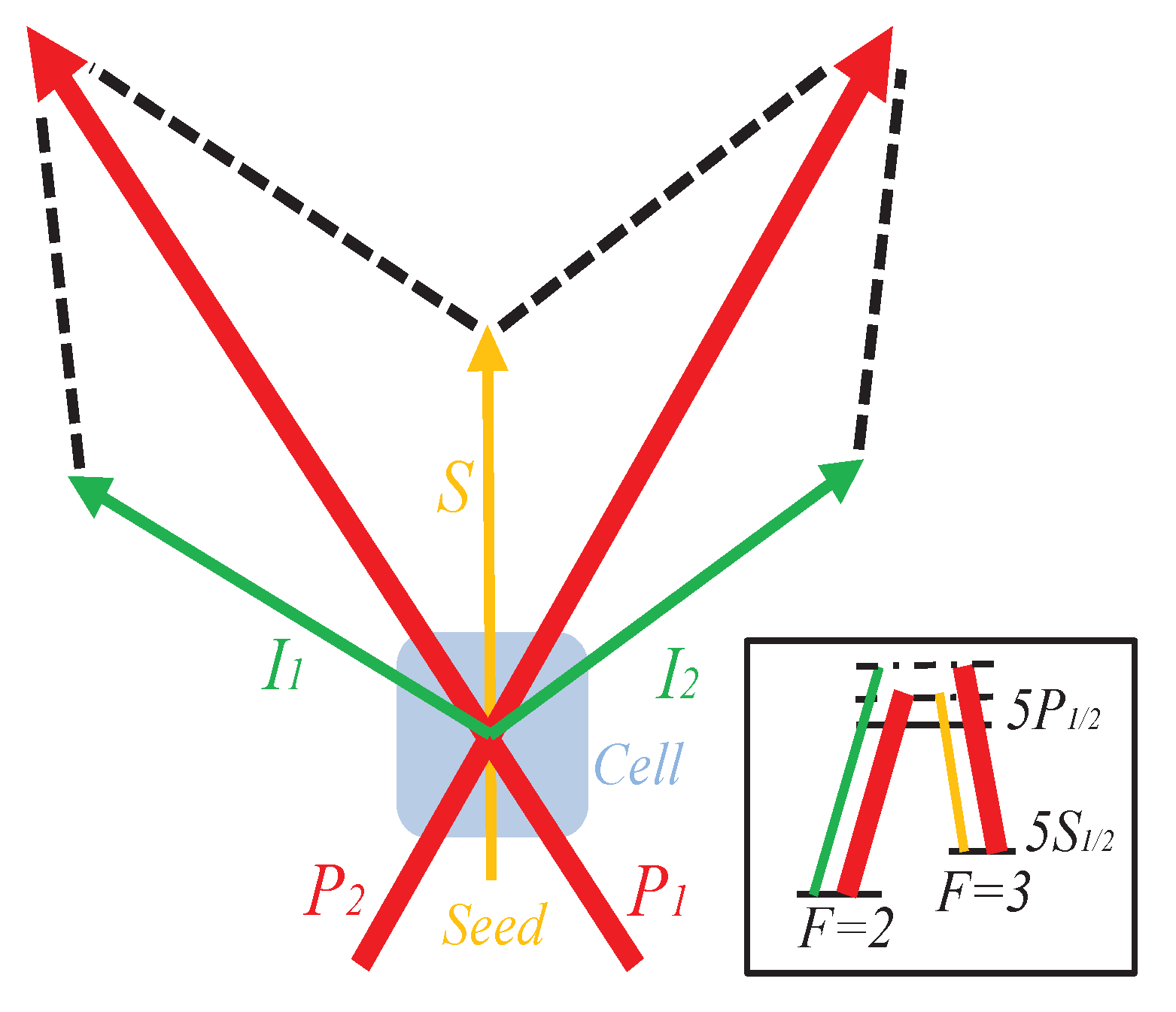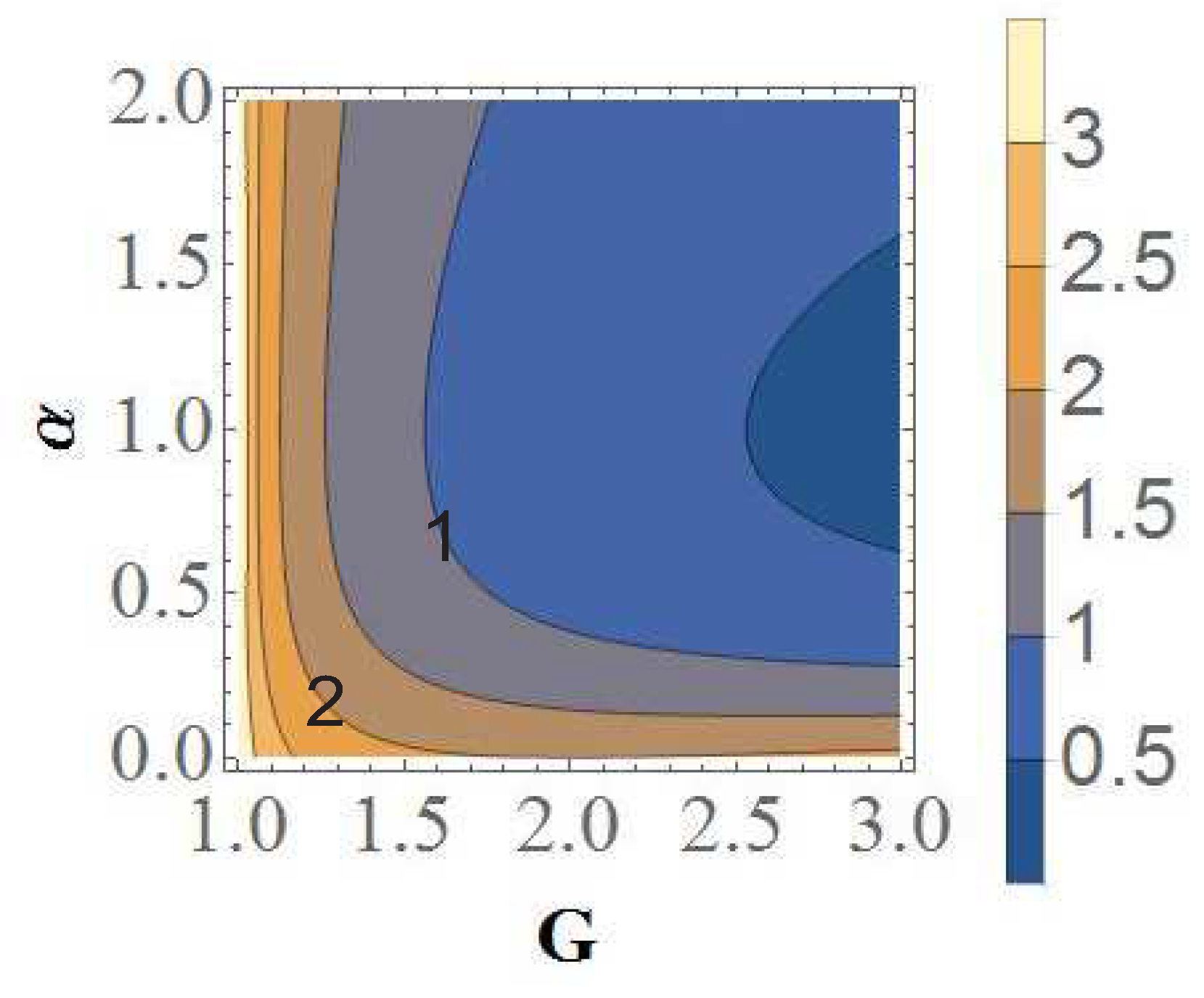Multi-Mode Correlation in a Concurrent Parametric Amplifier
Abstract
:1. Introduction
2. Two-Mode Entanglement
2.1. Duan Criterion
2.2. Positivity under Partial Transposition Criterion
3. Three-Mode Entanglement
3.1. Two-Condition Criterion
3.2. Optimal Single-Condition Criterion
3.3. PPT Criterion
4. Conclusions
Author Contributions
Funding
Conflicts of Interest
References
- Carman, R.L.; Chiao, R.Y.; Kelley, P.L. Observation of Degenerate Stimulated Four-Photon Interaction and Four-Wave Parametric Amplification. Phys. Rev. Lett. 1966, 17, 1281–1283. [Google Scholar] [CrossRef]
- Slusher, R.E.; Hollberg, L.W.; Yurke, B.; Mertz, J.C.; Valley, J.F. Observation of Squeezed States Generated by Four-Wave Mixing in an Optical Cavity. Phys. Rev. Lett. 1985, 55, 2409–2412. [Google Scholar] [CrossRef]
- Liu, Y.; Huo, N.; Li, J.; Li, X. Long-distance distribution of the telecom band intensity difference squeezing generated in a fiber optical parametric amplifier. Opt. Lett. 2018, 43, 5559–5562. [Google Scholar] [CrossRef]
- McCormick, C.F.; Boyer, V.; Arimondo, E.; Lett, P.D. Strong Relative Intensity Squeezing by Four-Wave Mixing in Rubidium Vapor. Opt. Lett. 2007, 33, 178–180. [Google Scholar] [CrossRef] [Green Version]
- Boyer, V.; Marino, A.M.; Pooser, R.C.; Lett, P.D. Entangled Images from Four-Wave Mixing. Science 2008, 321, 544–547. [Google Scholar] [CrossRef] [Green Version]
- Marino, A.M.; Pooser, R.C.; Boyer, V.; Lett, P.D. Tunable Delay of Einstein-Podolsky-Rosen Entanglement. Nature 2009, 457, 859–862. [Google Scholar] [CrossRef]
- Pooser, R.C.; Marino, A.M.; Boyer, V.; Jones, K.M.; Lett, P.D. Low-Noise Amplification of a Continuous-Variable Quantum State. Phys. Rev. Lett. 2009, 103, 010501. [Google Scholar] [CrossRef] [Green Version]
- Jing, J.; Liu, C.; Zhou, Z.; Ou, Z.Y.; Zhang, W. Realization of a Nonlinear Interferometer with Parametric Amplifiers. Appl. Phys. Lett. 2011, 99, 011110. [Google Scholar] [CrossRef]
- Hudelist, F.; Kong, J.; Liu, C.; Jing, J.; Ou, Z.Y.; Zhang, W. Quantum Metrology with Parametric Amplifier-Based Photon Correlation Interferometers. Nat. Commun. 2014, 5, 3049. [Google Scholar] [CrossRef] [Green Version]
- Qin, Z.; Cao, L.; Wang, H.; Marino, A.M.; Zhang, W.; Jing, J. Experimental Generation of Multiple Quantum Correlated Beams from Hot Rubidium Vapor. Phys. Rev. Lett. 2014, 113, 023602. [Google Scholar] [CrossRef] [Green Version]
- Fang, Y.; Jing, J. Quantum Squeezing and Entanglement from a Two-Mode Phase-Sensitive Amplifier via Four-Wave Mixing in Rubidium Vapor. New J. Phys. 2015, 17, 023027. [Google Scholar] [CrossRef] [Green Version]
- Fang, Y.; Feng, J.; Cao, L.; Wang, Y.; Jing, J. Experimental Implementation of a Nonlinear Beamsplitter Based on a Phase-Sensitive Parametric Amplifier. Appl. Phys. Lett. 2016, 108, 131106. [Google Scholar] [CrossRef]
- Wu, M.C.; Schmittberger, B.L.; Brewer, N.R.; Speirs, R.W.; Jones, K.M.; Lett, P.D. Twin-beam intensity-difference squeezing below 10 Hz. Opt. Express 2019, 27, 4769–4780. [Google Scholar] [CrossRef]
- Corzo, N.V.; Marino, A.M.; Jones, K.M.; Lett, P.D. Noiseless Optical Amplifier Operating on Hundreds of Spatial Modes. Phys. Rev. Lett. 2012, 109, 043602. [Google Scholar] [CrossRef]
- Boyer, V.; Marino, A.M.; Lett, P.D. Generation of Spatially Broadband Twin Beams for Quantum Imaging. Phys. Rev. Lett. 2008, 100, 143601. [Google Scholar] [CrossRef] [Green Version]
- Daems, D.; Bernard, F.; Cerf, N.J.; Kolobov, M.I. Tripartite entanglement in parametric down-conversion with spatially structured pump. J. Opt. Soc. Am. B 2010, 27, 447–451. [Google Scholar] [CrossRef] [Green Version]
- Duan, L.M.; Giedke, G.; Cirac, J.I.; Zoller, P. Inseparability Criterion for Continuous Variable Systems. Phys. Rev. Lett. 2000, 84, 2722–2725. [Google Scholar] [CrossRef] [Green Version]
- Simon, R. Peres-Horodecki Separability Criterion for Continuous Variable Systems. Phys. Rev. Lett. 2000, 84, 2726–2729. [Google Scholar] [CrossRef] [Green Version]
- Werner, R.F.; Wolf, M.M. Bound Entangled Gaussian States. Phys. Rev. Lett. 2001, 86, 3658–3661. [Google Scholar] [CrossRef] [Green Version]
- Barbosa, F.A.S.; de Faria, A.J.; Coelho, A.S.; Cassemiro, K.N.; Villar, A.S.; Nussenzveig, P.; Martinelli, M. Disentanglement in Bipartite Continuous-Variable Systems. Phys. Rev. A 2011, 84, 052330. [Google Scholar] [CrossRef] [Green Version]
- Barbosa, F.A.S.; Coelho, A.S.; de Faria, A.J.; Cassemiro, K.N.; Villar, A.S.; Nussenzveig, P.; Martinelli, M. Robustness of bipartite Gaussian entangled beams propagating in lossy channels. Nat. Photonics 2010, 4, 858–861. [Google Scholar] [CrossRef]
- Loock, P.V.; Furusawa, A. Detecting genuine multipartite continuous-variable entanglement. Phys. Rev. A 2003, 67, 052315. [Google Scholar] [CrossRef] [Green Version]
- Coelho, A.S.; Barbosa, F.A.S.; Cassemiro, K.N.; Villar, A.S.; Martinelli, M.; Nussenzveig, P. Three-Color Entanglement. Science 2009, 326, 823–826. [Google Scholar] [CrossRef] [Green Version]







Publisher’s Note: MDPI stays neutral with regard to jurisdictional claims in published maps and institutional affiliations. |
© 2022 by the authors. Licensee MDPI, Basel, Switzerland. This article is an open access article distributed under the terms and conditions of the Creative Commons Attribution (CC BY) license (https://creativecommons.org/licenses/by/4.0/).
Share and Cite
Wang, H.; Shi, Y. Multi-Mode Correlation in a Concurrent Parametric Amplifier. Photonics 2022, 9, 443. https://doi.org/10.3390/photonics9070443
Wang H, Shi Y. Multi-Mode Correlation in a Concurrent Parametric Amplifier. Photonics. 2022; 9(7):443. https://doi.org/10.3390/photonics9070443
Chicago/Turabian StyleWang, Hailong, and Yunpeng Shi. 2022. "Multi-Mode Correlation in a Concurrent Parametric Amplifier" Photonics 9, no. 7: 443. https://doi.org/10.3390/photonics9070443
APA StyleWang, H., & Shi, Y. (2022). Multi-Mode Correlation in a Concurrent Parametric Amplifier. Photonics, 9(7), 443. https://doi.org/10.3390/photonics9070443



